元気なクラブづくりのために - Rotary International
元気なクラブづくりのために - Rotary International
元気なクラブづくりのために - Rotary International
Create successful ePaper yourself
Turn your PDF publications into a flip-book with our unique Google optimized e-Paper software.
Be a Vibrant Club<br />
Your Club Leadership Plan
The Object of <strong>Rotary</strong> is to<br />
encourage and foster the ideal of service<br />
as a basis of worthy enterprise and, in<br />
particular, to encourage and foster:<br />
FIRST: The development of acquaintance<br />
as an opportunity for service;<br />
SECOND: High ethical standards in<br />
business and professions; the recognition<br />
of the worthiness of all useful occupations;<br />
and the dignifying of each Rotarian’s<br />
occupation as an opportunity to serve<br />
society;<br />
THIRD: The application of the ideal<br />
of service in each Rotarian’s personal,<br />
business, and community life;<br />
FOURTH: The advancement of<br />
international understanding, goodwill,<br />
and peace through a world fellowship of<br />
business and professional persons united in<br />
the ideal of service.<br />
Avenues of Service<br />
Club Service<br />
Vocational Service<br />
Community Service<br />
<strong>International</strong> Service<br />
New Generations Service<br />
Your <strong>Rotary</strong> Club<br />
What is your club like? Is it fun<br />
and energetic? Does it stand out<br />
and make you proud? Does it have<br />
its own identity? Is it known for a<br />
signature activity? Are its members<br />
diverse? open to new ideas? involved?<br />
When you think about your club,<br />
is it everything you want it to be?<br />
This guide provides best practices of<br />
successful <strong>Rotary</strong> clubs that can help<br />
your club become a more vibrant one.<br />
<strong>Rotary</strong>’s History<br />
of Service<br />
The Object of <strong>Rotary</strong> and the Avenues<br />
of Service capture the spirit of service<br />
that has long defined <strong>Rotary</strong>. Today,<br />
<strong>Rotary</strong> clubs carry on the tradition<br />
of service by meeting the needs of<br />
their members and community and<br />
by staying relevant, flexible, and<br />
innovative for their members and<br />
community — each club in its own way.<br />
The tradition of service can take many<br />
forms. How will your club continue<br />
this tradition? Will your club take<br />
advantage of its autonomy to reach its<br />
fullest potential?<br />
This is the 2010 edition of Be a Vibrant Club: Your Club Leadership Plan (245-EN; formerly titled Club Leadership Plan).<br />
If you have questions or comments, submit them to:<br />
Leadership Education and Training Division • <strong>Rotary</strong> <strong>International</strong> • One <strong>Rotary</strong> Center • 1560 Sherman Avenue •<br />
Evanston, IL 60201-3698 USA • E-mail: leadership.training@rotary.org • Phone: 847-866-3000 • Fax: 847-866-9446 •<br />
www.rotary.org.
Best Practices<br />
Strong clubs foster innovation and flexibility. This collection of best practices is intended to strengthen<br />
clubs — the first priority of the RI Strategic Plan — by motivating members to implement new ideas to<br />
increase the vitality of the club. Consider these as tips that can be tailored to make your club stronger.<br />
These best practices include:<br />
• Developing long-range goals that address the elements of an effective club<br />
• Setting annual goals that support long-range goals<br />
• Keeping all members involved and informed<br />
• Communicating effectively with club members and district leaders<br />
• Ensuring continuity in leadership from year to year<br />
• Customizing the bylaws to reflect club operations<br />
• Providing regular fellowship opportunities<br />
• Actively involving all club members<br />
• Offering regular, consistent training<br />
• Assigning committees that support your club’s operational needs, including:<br />
administration, membership, public relations, service projects, and<br />
The <strong>Rotary</strong> Foundation<br />
Your club procedures may already incorporate these practices. As you read through the best practices in<br />
this guide, focus on ones your club could implement or improve.<br />
Getting Started<br />
Has your club<br />
evaluated its<br />
traditions and<br />
practices lately<br />
to determine<br />
whether they<br />
are contributing<br />
to your club’s<br />
vitality?<br />
Use this guide to evaluate your club’s current practices and implement some of the recommended best<br />
practices to increase member involvement, community awareness, and club effectiveness. Assessing<br />
your club and considering new ways of running it is no easy task, but it is well worth the time and<br />
effort of every member. Consider having a daylong retreat or a series of meetings six months before the<br />
start of the new <strong>Rotary</strong> year to discuss how your club will implement these best<br />
practices. Consider holding these meetings in a new location to foster member<br />
creativity and give all members a chance to voice their opinions. Involving<br />
all members illustrates that the club is the responsibility of all members and<br />
demonstrates the goal to have a club of leaders who are committed to service and<br />
the club’s future. Club members will be invigorated and committed to making<br />
your club outstanding.<br />
Going forward, review these practices with your members annually to ensure<br />
they continue to meet the club’s goals and reflect the club’s identity. Ask district<br />
leaders, particularly your assistant governor, for help as you implement and<br />
review your practices as needed throughout the year.<br />
The Strategic<br />
Planning Guide<br />
can help your<br />
club start a plan<br />
to becoming<br />
stronger, more<br />
effective, and<br />
more vibrant.<br />
As you read through each best practice, you will see the following icons:<br />
Questions to consider Ideas to try Resources on<br />
www.rotary.org<br />
BE A VIBRANT CLUB<br />
1
Develop long-range goals that address the elements<br />
of an effective club.<br />
All members of the club should be involved in setting long-range goals. These<br />
goals should cover the next three to five <strong>Rotary</strong> years and address the elements<br />
of an effective club: membership, service projects, The <strong>Rotary</strong> Foundation, and<br />
leadership development. They should also include strategies that build room<br />
for flexibility and innovation and plans for promoting your club’s successes in<br />
each element. As your club evolves, these goals should be updated.<br />
Devote a month of club meetings to developing a<br />
strategic plan using the Strategic Planning Guide.<br />
Spend the first meeting analyzing your club’s<br />
strengths and weaknesses, the opportunities and risks from<br />
your community; the second on your vision statement; the<br />
third on your major goals; and the fourth on your action<br />
plan.<br />
Schedule a club retreat to review the current strategic plan<br />
to evaluate and update our goals.<br />
What is<br />
our club’s<br />
vision<br />
statement?<br />
How can our club’s<br />
strategic plan be<br />
improved?<br />
Which members<br />
are involved in<br />
managing longrange<br />
goals?<br />
Strategic Planning Guide<br />
Use the Planning Guide for Effective<br />
<strong>Rotary</strong> Clubs to set annual goals that align<br />
with your club’s long-range goals.<br />
Annual goals help you reach your long-range goals over time.<br />
The planning guide helps you assess the current state of your<br />
club and set annual goals. These goals move the club toward<br />
your long-range goals that capitalize on your strengths and<br />
address areas of weakness. The guide should function as a<br />
working document that can be updated as needed.<br />
How do we determine our annual goals?<br />
How do we involve all members?<br />
How often do our club leaders review the planning<br />
guide?<br />
Ask club committees to<br />
propose annual goals.<br />
Conduct a community<br />
needs assessment before setting<br />
annual goals.<br />
Planning Guide for<br />
Effective <strong>Rotary</strong> Clubs<br />
(relevant sections can be<br />
found in the following manuals)<br />
Club President’s Manual<br />
Club Secretary’s Manual<br />
Club Treasurer’s Manual<br />
Club Administration, Membership,<br />
Public Relations, Service Projects,<br />
<strong>Rotary</strong> Foundation Committee<br />
Manuals<br />
2 BE A VIBRANT CLUB
Conduct club assemblies that<br />
involve members in the planning<br />
process and keep them informed<br />
of <strong>Rotary</strong> activities.<br />
Club assemblies help all club members stay<br />
current and feel included in club activities. Many<br />
clubs use assemblies as an opportunity for all<br />
members to discuss decisions that affect the club<br />
and for committees to report on their activities.<br />
Hold assemblies<br />
during regular<br />
club meetings.<br />
Hold a quarterly<br />
assembly for soliciting<br />
innovative ideas from<br />
all members.<br />
How will our assemblies solicit input from club members?<br />
What topics will our club address in this year’s assemblies?<br />
Who from the district can we invite to our assemblies?<br />
How often will we hold assemblies?<br />
Club meeting<br />
and assembly<br />
information<br />
(www.rotary.org<br />
Members Running a<br />
club Administration<br />
<strong>Rotary</strong> club meetings)<br />
Ensure clear communication between club leaders, club members,<br />
and district leaders.<br />
Club leaders should work together to develop a plan for communicating with each other, club<br />
members, and district leaders. In your communication plan, outline who will communicate with<br />
whom, what method will be used, and when.<br />
Who is<br />
responsible<br />
for informing<br />
members and district<br />
leaders of our club’s<br />
activities?<br />
How do we share<br />
information?<br />
Which social<br />
networking sites do<br />
we use?<br />
What information do<br />
we go to our district<br />
website for?<br />
Include a 10-minute open<br />
forum at the end of a club<br />
meeting once a month during<br />
which club members are encouraged to<br />
present new ideas or a topic for<br />
discussion.<br />
Update your club website on a weekly or<br />
monthly basis. Share this responsibility<br />
with a group of members or all<br />
members, based on their role.<br />
For members who are not regular<br />
Internet users, partner them with<br />
someone in the club who can help them<br />
navigate the club website and social<br />
networking sites, or provide printouts<br />
as appropriate.<br />
Best Web<br />
Design<br />
Practices<br />
(www.rotary.org<br />
/graphics Best Web<br />
design practices)<br />
BE A VIBRANT CLUB<br />
3
Provide for continuity<br />
in leadership to ensure<br />
development of future<br />
leaders.<br />
Because <strong>Rotary</strong> club leadership<br />
changes annually, every club<br />
needs a continual supply of<br />
potential leaders; those leaders<br />
must work together from year<br />
to year. There are many ways to<br />
achieve continuity, including<br />
making appointments for<br />
multiple years; having a current,<br />
incoming, and past chair on<br />
all committees; and having the<br />
current club president work<br />
closely with the presidentelect,<br />
president-nominee, and<br />
immediate past president.<br />
How do<br />
we ensure<br />
that we<br />
have enough<br />
candidates to<br />
assume new club<br />
positions this<br />
year?<br />
How does our<br />
club coordinate<br />
the management<br />
of projects that<br />
last more than<br />
one year?<br />
What position<br />
should someone<br />
hold before<br />
becoming<br />
president?<br />
Distribute<br />
a list of<br />
offices with<br />
descriptions of<br />
responsibilities to<br />
all members.<br />
Conduct “on the<br />
job training” for<br />
incoming club<br />
officers at least<br />
one month before<br />
taking office.<br />
Organize a<br />
leadership<br />
development<br />
program to<br />
prepare interested<br />
members for<br />
leadership roles.<br />
Assign new members<br />
a mentor who<br />
is a past president<br />
or current club<br />
officer.<br />
Leadership<br />
Development:<br />
Your<br />
Guide to Starting a<br />
Program<br />
Club President’s<br />
Manual<br />
Club Secretary’s<br />
Manual<br />
Club Treasurer’s<br />
Manual<br />
Club<br />
Administration,<br />
Membership,<br />
Public Relations,<br />
Service Projects,<br />
<strong>Rotary</strong> Foundation<br />
Committee<br />
Manuals<br />
Amend club bylaws to reflect the club committee<br />
structure and roles and responsibilities of<br />
club leaders.<br />
Modify the Recommended <strong>Rotary</strong> Club Bylaws from RI to reflect your<br />
club’s operations. Your club’s bylaws provide guidelines for managing the<br />
club. The Recommended <strong>Rotary</strong> Club Bylaws are intended to be flexible to<br />
meet the individual needs of each club. Take and adapt them to meet your<br />
club’s unique identity. Over time, as your club’s practices evolve, revisit<br />
your bylaws and revise them to reflect new practices and procedures.<br />
Which club<br />
operations have<br />
changed in the<br />
last year?<br />
Are there any procedural<br />
changes we’d like to<br />
“test run”?<br />
When was the last time<br />
we reviewed or amended<br />
our club bylaws?<br />
Are our club bylaws<br />
easily accessible for club<br />
members?<br />
Ask members to review your bylaws and offer<br />
suggested changes at a scheduled club meeting.<br />
Consider running club board-approved pilot<br />
tests of new club procedures to see if they work before<br />
amending your bylaws.<br />
Recommended<br />
<strong>Rotary</strong> Club<br />
Bylaws<br />
Standard <strong>Rotary</strong> Club<br />
Constitution<br />
4 BE A VIBRANT CLUB
Provide<br />
opportunities<br />
to develop<br />
stronger<br />
relationships<br />
among fellow<br />
club members.<br />
Members who enjoy<br />
<strong>Rotary</strong> will feel more<br />
involved. Strong club<br />
relationships will also<br />
support your club’s<br />
service efforts.<br />
Do our weekly club meetings include time for<br />
networking and social interaction?<br />
Do our club activities include family members?<br />
How is our club using district or <strong>Rotary</strong> <strong>International</strong><br />
events and groups to enhance relationships?<br />
Hold monthly social events to help club members get to know each other<br />
in a different setting.<br />
Conduct annual surveys to find out what kinds of social events members<br />
would like to attend and days of the week and times that are convenient.<br />
Designate one club meeting every month or quarter for networking with other<br />
members to learn more about each other’s profession.<br />
Make your service projects fun to further develop relationships among members.<br />
<strong>Rotary</strong> Fellowships Handbook<br />
Convention registration at<br />
www.rotary.org/convention<br />
Ensure that every member is active in a<br />
club project or function.<br />
Club involvement teaches members about <strong>Rotary</strong> and helps retain<br />
them as active members of the club. Active members feel ownership<br />
of and dedication to their club’s projects.<br />
In what ways does our<br />
club get members<br />
involved in club<br />
projects?<br />
How often do we ask members<br />
what they want from the club<br />
or what they like and what<br />
they would like to change?<br />
How do we ensure that all<br />
members voice their opinions?<br />
Are our club’s projects diverse?<br />
Ask members to help in<br />
an area that interests them<br />
rather than waiting for<br />
them to volunteer.<br />
Conduct a member interest<br />
survey, and use the results to<br />
plan projects and activities and to<br />
develop weekly programs.<br />
Have your weekly meeting be<br />
a service project rather than a<br />
presentation.<br />
Communities in<br />
Action<br />
Club Assessment Tools<br />
ProjectLINK (www.rotary.org<br />
/projectlink)<br />
BE A VIBRANT CLUB<br />
5
What is our<br />
club’s process for<br />
orienting new<br />
members?<br />
How many of our club<br />
members are involved at<br />
the district level?<br />
How does our club<br />
develop the leadership<br />
skills of our members?<br />
Develop a comprehensive training plan.<br />
Training is crucial for developing future leaders and ensuring that current<br />
club officers are well informed about <strong>Rotary</strong>, capable of leading the club,<br />
and providing better <strong>Rotary</strong> service. A comprehensive training plan<br />
ensures that these areas are addressed:<br />
• Club leaders attend district training meetings.<br />
• Orientation for new members is provided consistently and regularly.<br />
• Ongoing educational opportunities are available for current members.<br />
• A leadership skills development program is available for all members.<br />
Appoint a club trainer or training<br />
committee to oversee the training plan<br />
for your club.<br />
Conduct a leadership skills assessment to see<br />
what skills your members would like to learn.<br />
New Members information (www.rotary.org<br />
Members New members)<br />
Training information (www.rotary.org<br />
Members Training)<br />
New Member Orientation<br />
Leadership Development: Your Guide to Starting a Program<br />
Leadership Development Training Cycle<br />
Assign committees<br />
that support your<br />
club’s needs.<br />
These committees include:<br />
• Club administration<br />
• Membership<br />
• Public relations<br />
• Service projects<br />
• The <strong>Rotary</strong> Foundation<br />
Appoint other committees<br />
as needed to support club<br />
goals. Whichever structure<br />
you choose, a committee<br />
should serve an advisory role<br />
that encourages member<br />
involvement and club action.<br />
What<br />
committees<br />
does<br />
our club have?<br />
How can we<br />
improve our<br />
current club<br />
structure?<br />
How do our<br />
committees<br />
coordinate their<br />
work?<br />
Small clubs:<br />
Consider how<br />
you can<br />
combine the work of<br />
committees.<br />
Large clubs: Consider<br />
having additional<br />
committees to get all<br />
members involved<br />
and maximize your<br />
service potential.<br />
Have a committee<br />
to plan each service<br />
project or for your<br />
club’s signature<br />
activity.<br />
Consider a completely<br />
new committee<br />
structure for your<br />
club.<br />
Club<br />
Committee<br />
Structure<br />
(www.rotary.org<br />
Members<br />
Running a club<br />
Administration<br />
<strong>Rotary</strong> club<br />
committees)<br />
Club<br />
Administration,<br />
Membership,<br />
Public Relations,<br />
Service Projects,<br />
<strong>Rotary</strong> Foundation<br />
Committee<br />
Manuals<br />
245-EN—(111)


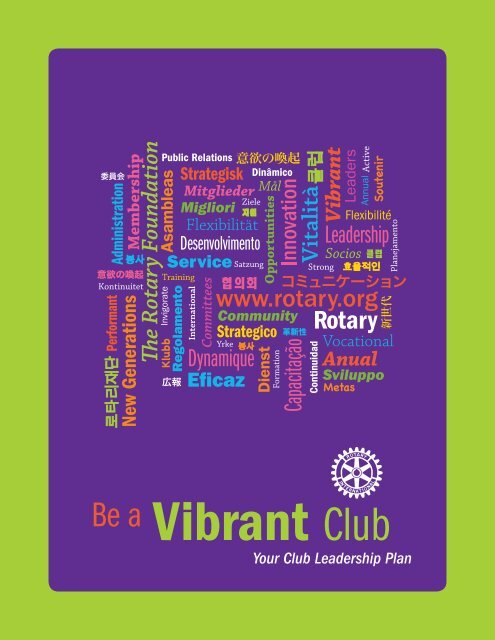
![La présidence du club [222-FR] - Rotary International](https://img.yumpu.com/25855726/1/190x245/la-presidence-du-club-222-fr-rotary-international.jpg?quality=85)

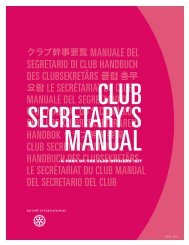




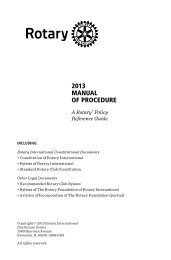
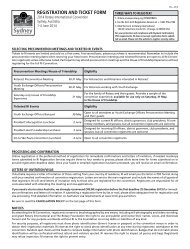

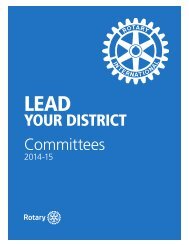

![La conférence de district [800-FR] - Rotary International](https://img.yumpu.com/25855636/1/190x245/la-conference-de-district-800-fr-rotary-international.jpg?quality=85)
